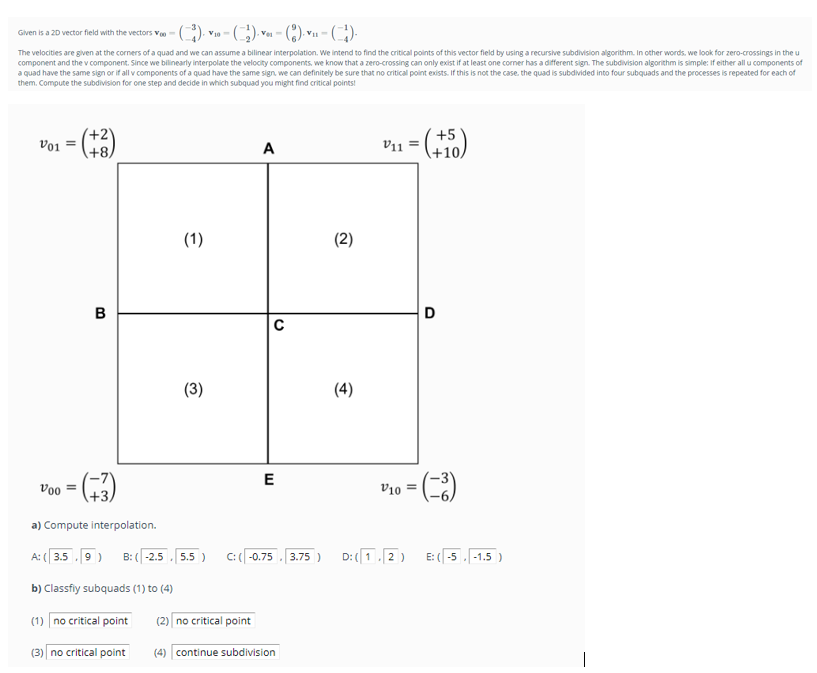Given is a 2D vector field with the vectors Voo ( V10- The velocities are given at the corners of a quad and we can assume a bilinear interpolation. We intend to find the critical points of this vector field by using a recursive subdivision algorithm. In other words, we look for zero-crossings in the u component and the v component. Since we bilinearly interpolate the velocity components, we know that a zero-crossing can only exist if at least one corner has a different sign. The subdivision algorithm is simple: If either all u components of a quad have the same sign or if all v components of a quad have the same sign, we can definitely be sure that no critical point exists. If this is not the case, the quad is subdivided into four subquads and the processes is repeated for each of them. Compute the subdivision for one step and decide in which subquad you might find critical points! V01 = (+2) B V0o= =(+3) a) Compute interpolation. A (1) (2) (3) 0 (4) V11 V₁₁ = (+50) E V10 = D A: (3.5,9) B: (-2.5 5.5) C: (-0.75, 3.75) D:(1.2) E: (-5.-1.5) b) Classfiy subquads (1) to (4) (1) no critical point (2) no critical point (3) no critical point (4) continue subdivision
Given is a 2D vector field with the vectors Voo ( V10- The velocities are given at the corners of a quad and we can assume a bilinear interpolation. We intend to find the critical points of this vector field by using a recursive subdivision algorithm. In other words, we look for zero-crossings in the u component and the v component. Since we bilinearly interpolate the velocity components, we know that a zero-crossing can only exist if at least one corner has a different sign. The subdivision algorithm is simple: If either all u components of a quad have the same sign or if all v components of a quad have the same sign, we can definitely be sure that no critical point exists. If this is not the case, the quad is subdivided into four subquads and the processes is repeated for each of them. Compute the subdivision for one step and decide in which subquad you might find critical points! V01 = (+2) B V0o= =(+3) a) Compute interpolation. A (1) (2) (3) 0 (4) V11 V₁₁ = (+50) E V10 = D A: (3.5,9) B: (-2.5 5.5) C: (-0.75, 3.75) D:(1.2) E: (-5.-1.5) b) Classfiy subquads (1) to (4) (1) no critical point (2) no critical point (3) no critical point (4) continue subdivision
Operations Research : Applications and Algorithms
4th Edition
ISBN:9780534380588
Author:Wayne L. Winston
Publisher:Wayne L. Winston
Chapter2: Basic Linear Algebra
Section2.4: Linear Independence And Linear Dependence
Problem 9P
Related questions
Question
I have provided a question with the answers.I want to understand the solution.how do we classify subquads in the task b

Transcribed Image Text:Given is a 2D vector field with the vectors Voo (
V10-
The velocities are given at the corners of a quad and we can assume a bilinear interpolation. We intend to find the critical points of this vector field by using a recursive subdivision algorithm. In other words, we look for zero-crossings in the u
component and the v component. Since we bilinearly interpolate the velocity components, we know that a zero-crossing can only exist if at least one corner has a different sign. The subdivision algorithm is simple: If either all u components of
a quad have the same sign or if all v components of a quad have the same sign, we can definitely be sure that no critical point exists. If this is not the case, the quad is subdivided into four subquads and the processes is repeated for each of
them. Compute the subdivision for one step and decide in which subquad you might find critical points!
V01 = (+2)
B
V0o=
=(+3)
a) Compute interpolation.
A
(1)
(2)
(3)
0
(4)
V11
V₁₁ = (+50)
E
V10 =
D
A: (3.5,9)
B: (-2.5
5.5)
C: (-0.75, 3.75) D:(1.2)
E: (-5.-1.5)
b) Classfiy subquads (1) to (4)
(1) no critical point
(2) no critical point
(3) no critical point
(4) continue subdivision
Expert Solution
This question has been solved!
Explore an expertly crafted, step-by-step solution for a thorough understanding of key concepts.
Step by step
Solved in 1 steps

Recommended textbooks for you

Operations Research : Applications and Algorithms
Computer Science
ISBN:
9780534380588
Author:
Wayne L. Winston
Publisher:
Brooks Cole

Operations Research : Applications and Algorithms
Computer Science
ISBN:
9780534380588
Author:
Wayne L. Winston
Publisher:
Brooks Cole